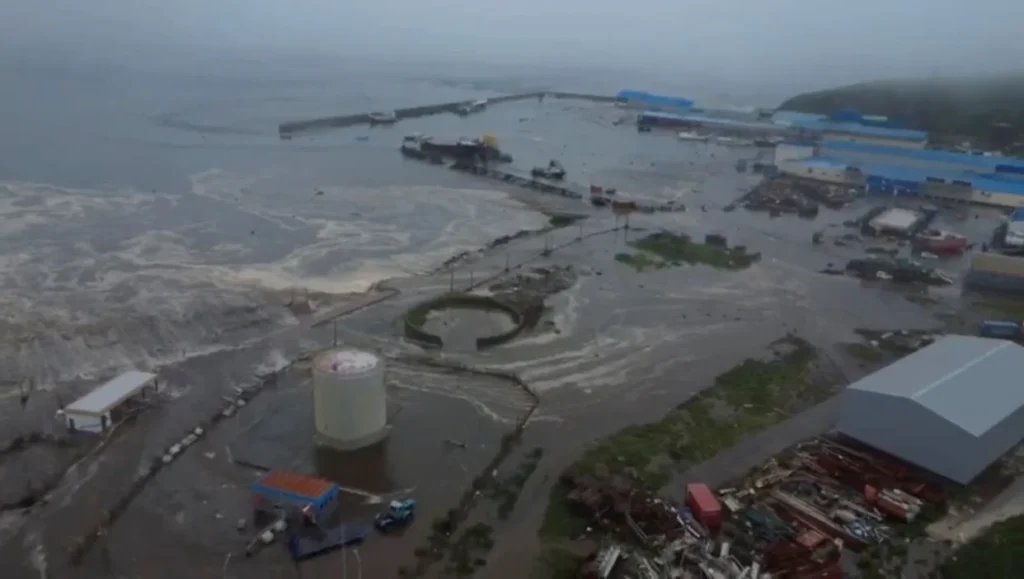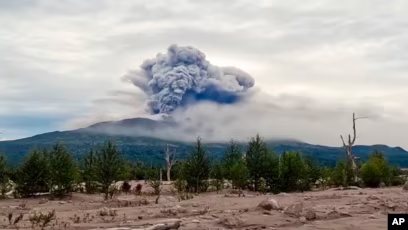Earth Roars Twice: Russia’s Tallest Volcano Erupts After 8.8 Magnitude Quake & Tsunami
The Earth beneath the Pacific Ocean heaved violently on Wednesday. A colossal 8.8 magnitude undersea earthquake sent shockwaves radiating outward, unleashing a tsunami that rose up to 13 feet (4 meters) and crashed onto Russia’s eastern coastline.

Buildings shook and cracked, evacuation sirens blared, and chaos unfolded across towns and villages in eastern Russia and Japan’s coastal areas. While several injuries were reported, thankfully, no deaths have been confirmed. As the water receded, residents braced for recovery — but nature wasn’t finished.
The Sequence of Fury: Quake Tsunami Fire
Just as communities began assessing the tsunami’s aftermath, the Earth delivered a final blow: Russia’s tallest volcano—Klyuchevskoy—erupted.
Timeline:
- The Quake: Struck under the Pacific Ocean floor, triggering immediate tsunami warnings.
- The Tsunami: Waves up to 13 feet hit Russia’s east coast and prompted warnings in Japan.
- The Eruption: The Klyuchevskoy volcano on the Kamchatka Peninsula, 450 km north of Petropavlovsk-Kamchatsky, exploded in a fiery display.
Russia’s United Geophysical Service confirmed lava flowing down the volcano’s western slope, explosions, and a “powerful glow” illuminating the crater.
Klyuchevskoy: Towering Titan of Eurasia
Klyuchevskoy (also known as Klyuchevskaya Sopka) is no ordinary mountain.
- Height: 4,750 meters (15,580 feet) — Eurasia’s tallest active volcano
- Location: Kamchatka Peninsula, part of the Pacific Ring of Fire
- Reputation: Frequent eruptions for centuries, especially in the 20th and 21st centuries
Its snow-covered cone hides a boiling, explosive core. Kamchatka itself hosts over 300 volcanoes, 30 of which are active. With thin crust and constant tectonic activity, it’s one of the most volatile places on Earth.
The “Powerful Glow”: What It Really Means
The “glow” seen above the volcano is not just visual drama — it’s a scientific signal:
- Molten Lava: Lava at over 1,000°C glowing as it moves
- Explosive Activity: Violent eruptions ejecting fiery rock into the sky
- Ice Interaction: Snow and lava clash, creating steam, light, and deadly lahars (mudflows)
This glow means intense volcanic energy — dangerous for nearby zones and for aircraft in the skies.
Tourists: Not Running, But Watching
Surprisingly, tourism hasn’t slowed.
According to the Russian Union of Travel Industry (RUTI) via CNN, there were no tour cancellations, even as lava flowed and the crater glowed. In fact, many tourists want to stay and witness it.
Why?
- Adventure & Extreme Travel: Eruption is a once-in-a-lifetime experience
- Photography & Research: A golden moment for volcano lovers and scientists
- Managed Tours: Operators keep tourists at “safe” distances, mostly from the foothills
Kamchatka is not for the faint of heart, and these tourists signed up for precisely this kind of wild encounter.
Did the Quake Trigger the Eruption? Science Says… Maybe
The burning question: Is the earthquake responsible for the eruption?
Here’s what we know:
- Large quakes can change underground pressure, unclamping magma
- Seismic waves can shake magma chambers, triggering gas expansion
- Crust can fracture, allowing magma to rise more easily
However, Klyuchevskoy was already active, and eruptions were expected. So, was this eruption coincidental or quake-triggered?
Scientists are analyzing:
- Timing patterns
- Seismic activity before/after the quake
- Stress models and crust deformation data
Verdict: A possible connection exists, but it’s too early to be definitive.
The Ring of Fire’s Deadly Dance
The Pacific Ring of Fire — a tectonic belt stretching from Japan to Chile — is home to 75% of Earth’s volcanoes and most of its massive earthquakes. Kamchatka lies directly on it, making such events likely — but rarely in such fast succession.
In a span of hours, Kamchatka faced:
- Tectonic rupture (quake)
- Hydrospheric power (tsunami)
- Magmatic explosion (eruption)
It’s nature’s deadly chain reaction — a reminder of how interconnected Earth’s systems are.
The Visual Impact: Fire on Snow
Against the snowy backdrop of Kamchatka, the image of Klyuchevskoy glowing red at night, lava flowing like rivers of fire, is both terrifying and beautiful. Locals, scientists, and tourists alike are all bearing witness to the immense power of our planet.
Key Takeaways
- Russia’s eastern coast was rocked by a massive 8.8 earthquake and tsunami
- Klyuchevskoy volcano erupted shortly after, displaying lava flows and glowing skies
- Tourists are staying put, eager to watch the eruption despite the danger
- Scientists are still determining whether the quake triggered the eruption
- The Kamchatka Peninsula remains one of the most geologically active regions in the world
Safety and Monitoring Continue
Authorities have:
- Issued air travel alerts due to ash clouds
- Warned residents to avoid contaminated water
- Activated emergency teams in quake-hit zones
Kamchatka locals are no strangers to nature’s fury — but this triple strike demands increased vigilance and scientific attention.
Earth’s Power, Humanity’s Curiosity
The Earth has spoken twice this week — first with water, then with fire. From tsunami-ravaged coasts to volcanic slopes glowing in the night, Kamchatka is once again at the heart of nature’s untamed energy.
As tourists watch in awe, and scientists study the connection between quake and eruption, one thing is clear: our planet is alive, unpredictable, and immensely powerful. And yet, we are drawn to it — not just to survive it, but to understand it, photograph it, and marvel at it.
Follow us for more news at Valleynewz.com

